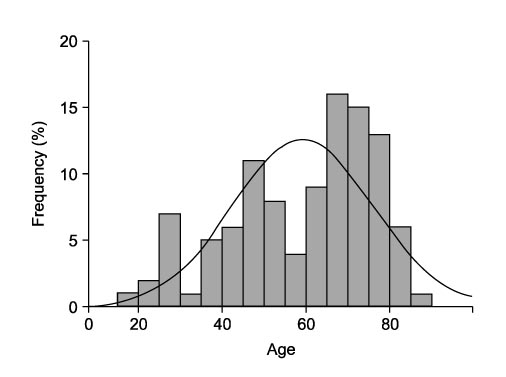Tuberc Respir Dis.
2009 Feb;66(2):116-121.
A Correlation between Pulmonary Involvement of Acute Febrile Illness with High Incidence during the Fall and C-reactive Protein
- Affiliations
-
- 1Division of Pulmonary, Allergy and Critical Care Medicine, Department of Internal Medicine, Chuncheon Sacred Heart Hospital, Chuncheon, Korea. doclcy@hallym.or.kr
- 2Lung Research Institute of Hallym University College of Medicine, Chuncheon, Korea.
Abstract
- BACKGROUND
Tsutsugamushi, leptospirosis and hemorrhagic fever with renal syndrome (HFRS) are the prevalent diseases among the acute febrile illnesses in Korea. Pulmonary involvement in the patients with these diseases remains poorly recognized in endemic regions, and this is despite reports of recent outbreaks and epidemic episodes. Pulmonary involvement and a higher CRP level as clinical manifestations show a more severe form of infection. The aim of this study is to analyze the correlation of pulmonary involvement and the CRP level in patients with acute febrile illnesses.
METHODS
We retrospectively reviewed the clinical records of 105 patients who were diagnosed with tsutsugamushi, HFRS and leptospirosis from January 2002 to May 2008 in Chuncheon Sacred Heart Hospital. The radiographic images were retrospectively analyzed by two radiologists. We analyzed the pulmonary complications of the patients with these febrile diseases and we checked the CRP level at admission.
RESULTS
The study included 105 patients who were diagnosed with febrile diseases. Of these patients, 32 patients had hantaan, 10 patients had leptospirosis and 63 patients had tsutsugamushi disease. 42 (40%) patients had pulmonary complications, 20 patients had pulmonary edema, 20 patients had pleural effusion and 2 patients had interstitial pneumonitis. The patients with pulmonary involvement showed a more severe form of infection and a higher CRP level than that of those patients without pulmonary involvement (p=0.0073).
CONCLUSION
Pulmonary involvement in patients with acute febrile diseases might be correlated with a higher CRP level. Identification of this factor on admission might provide useful selection criteria for the patients who need early intensive care.
Keyword
MeSH Terms
Figure
Reference
-
1. Song JW, Lee JE, Kim SH, Kee SH, Park KS, Baek LJ, et al. Seroepidemiologic analysis of acute febrile illness in Korea during 1997-1998. J Bacteriol Virol. 2002. 32:263–267.2. Munro-Faure AD, Andrew R, Missen GA, Mackay-Dick J. Scrub typhus in Korea. J R Army Med Corps. 1951. 97:227–229.3. Weil A. Ueber Eile Eligenthumliche, Mit Miltz tumor. Icterus and Nephritis Einhergehende. Acute infectionskrankheit Dtsch Arch Klin Med. 1886. 39:209–232.4. Martínez García MA, de Diego Damiá A, Menéndez Villanueva R, López Hontagas JL. Pulmonary involvement in leptospirosis. Eur J Clin Microbiol Infect Dis. 2000. 19:471–474.5. Thammakumpee K, Silpapojakul K, Borrirak B. Lep tospirosis and its pulmonary complications. Respirology. 2005. 10:656–659.6. Lee WS, Wang FD, Wang LS, Wong WW, Young D, Fung CP, et al. Scrub typhus complicating acute respiratory distress syndrome: a report of two cases. Zhong hua Yi Xue Za Zhi (Taipei). 1995. 56:205–210.7. Park HK, Jung SJ, Lee SP, Jin SH, Lee KH, Park DC, et al. Clinical study of 27 patients with Tsutsugamushi disease in the Ulsan, Ulchu Area. Korean J Med. 1988. 35:383–389.8. Jeon KY, Choi YS. Clinical observation of 98 cases of Tsutsugamushi disease (1986-1991). Korean J Med. 1993. 45:177–186.9. Burke BJ, Searle JF, Mattingly D. Leptospirosis presenting with profuse haemoptysis. Br Med J. 1976. 2:982.10. Havens WP, Buchar CJ, Raimann HA. Leptospirosis. JAMA. 1941. 116:289.11. Chiu YC, Liu HH. Report on observation roentgenologic pulmonary changes in 48 cases of leptopirosis. Chin J Radiol. 1959. 7:374–375.12. Kim WY, Han SY, Kim SK, Suh JE, Joo SA, Kim KM. The 16 cases of leptospirosis in Chuncheon area. Korean J Med. 1986. 30:745–750.13. Kim HJ, Jung JH, Lee JU, Lee OY, Yang SC, Han DS, et al. Chest X-ray findings and acid-base disturbances in the early phase of Leptospirosis. Korean J Med. 1997. 52:24–31.14. Padula PJ, Edelstein A, Miguel SD, López NM, Rossi CM, Rabinovich RD. Hantavirus pulmonary syndrome outbreak in Argentina: molecular evidence for person-to-person transmission of Andes virus. Virology. 1998. 241:323–330.15. Graziano KL, Tempest B. Hantavirus pulmonary syndrome: a zebra worth knowing. Am Fam Physician. 2002. 66:1015–1020.16. Khan AS, Ksiazek TG, Peters CJ. Hantavirus pulmonary syndrome. Lancet. 1996. 347:739–741.
- Full Text Links
- Actions
-
Cited
- CITED
-
- Close
- Share
- Similar articles
-
- The Diagnostic Value of Serum C-Reactive Protein in Patients Suspected to Have Acute Appendicitis
- Treatment of Acute Febrile Illness during the Fall
- The Influence of Low Serum Sodium Levels on the Risk of Repeated Febrile Convulsions during the Same Febrile Illness
- Two Cases of Acute Febrile Neutrophilic Dermatosis (Sweet's Syndrome)
- Relationship between Recurrence in Febrile Seizures and Serum Zinc Levels






